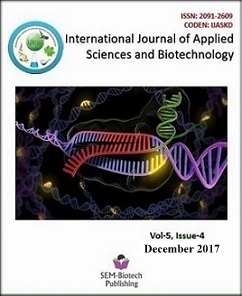Use of Crispr/Cas9 for Development of Disease Resistant Cultivars in Plant Breeding
DOI:
https://doi.org/10.3126/ijasbt.v5i4.18523Keywords:
CRISPR/Cas9, plant breeding, resistance breedingAbstract
Crop protection against pests and diseases is a major challenge in agriculture. Plant breeding is a key solution for the development of disease resistant cultivars. Gene editing is an indispensable part of plant breeding to obtain desirable traits in crops. CRISPR (Clustered Regular Interspaced Palindromic Repeats)/Cas9 (CRISPR- associated protein) is a recent breakthrough in gene editing technology. It can be utilized to exploit defensive mechanism in plants against pathogen attack with recognition and degradation of the invading pathogenic genes by bacterial immune system. Advances in plant breeding with integration of CRISPR/Cas9 have facilitated the production of cultivars with heritable resistance to viral and bacterial disease. CRISPR/Cas9 mediated genetically engineered resistance can be inherited to further generation of crops after segregation of Cas9/sgRNA transgene in F1 generation. The segregation of Cas9/sgRNA transgene prevents undesirable genome modification in successive generation and makes use of CRISPR/Cas9 safe in plant breeding. CRISPR/Cas9 proves itself as a fascinating tool to revolutionize plant breeding for the development of various disease resistant cultivars however, effects of CRISPR/Cas9 system on different physiological process of plants still needs to be studied.
Int. J. Appl. Sci. Biotechnol. Vol 5(4): 403-409




